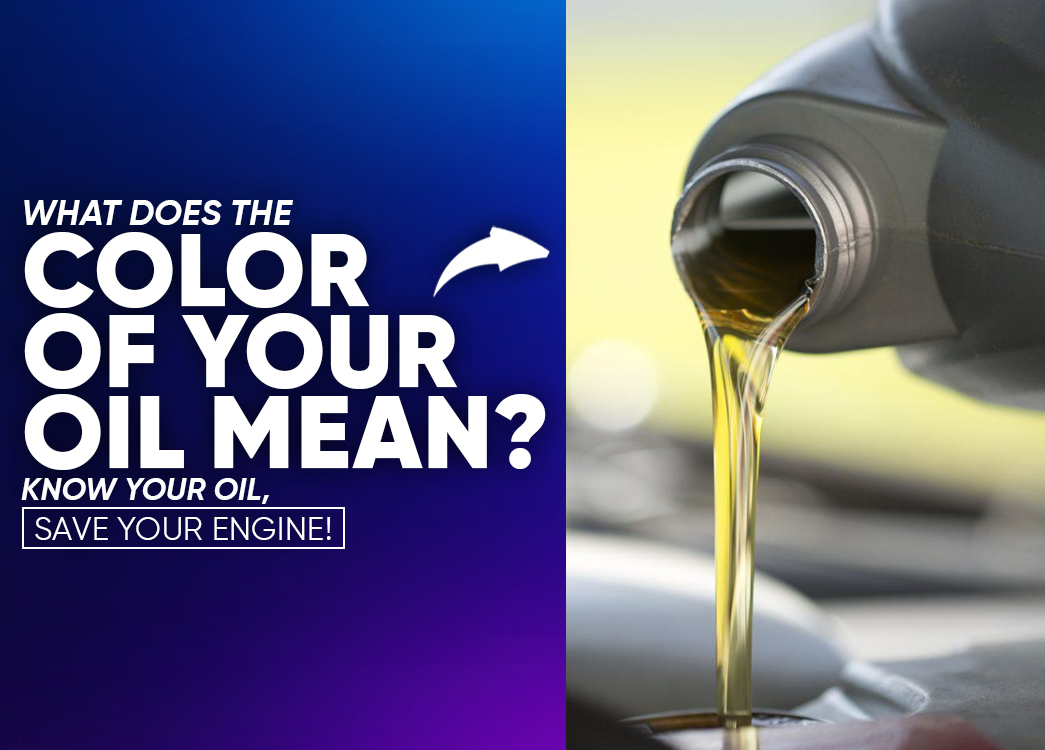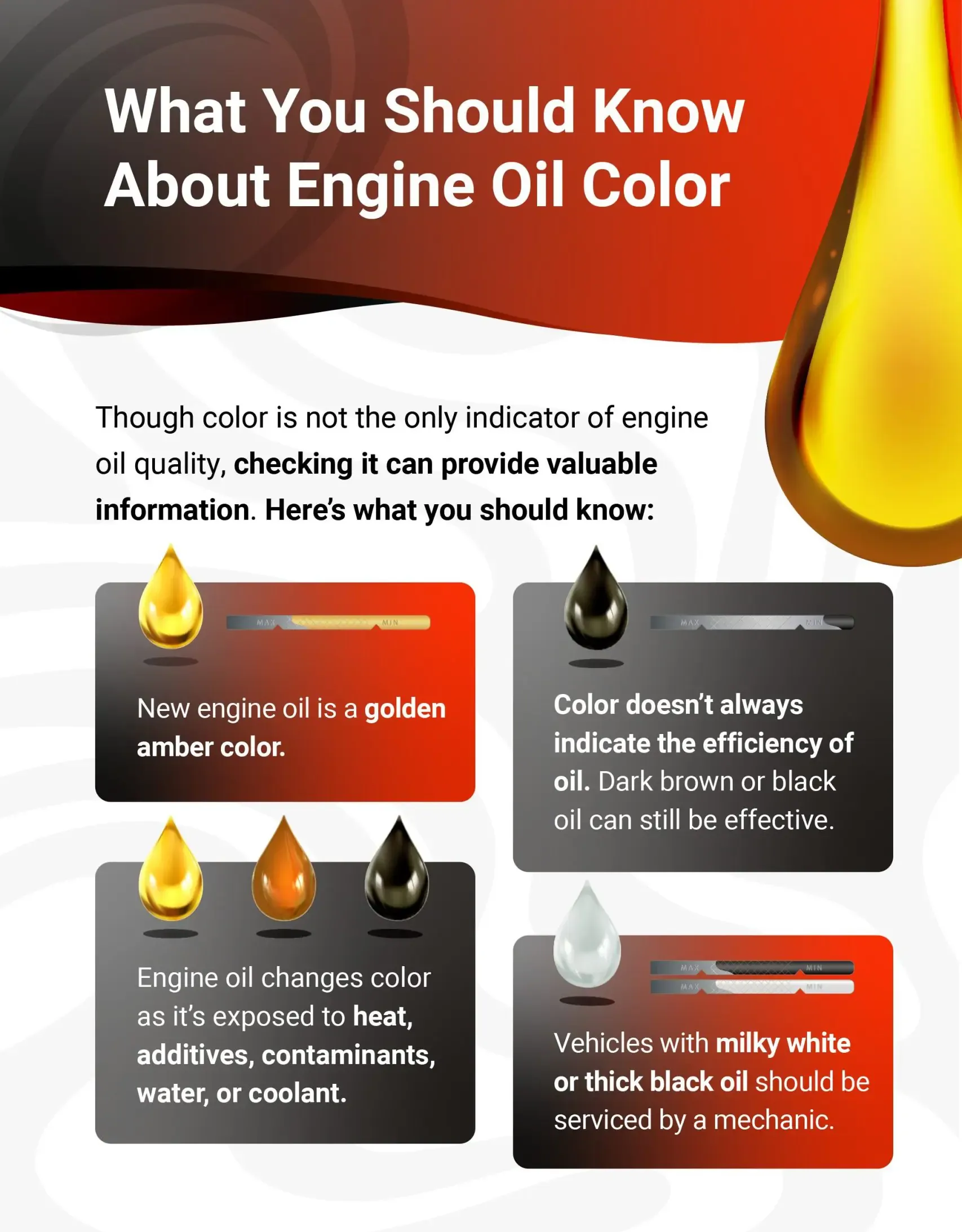
By creckk On 05-08-2025 at 12:12 pm
What Your Engine Oil Color is Telling You - Truth, Myths & What to Do!
What Does The Color of Your Oil Mean?
Over time, the quality, consistency, and color of your oil-based lubricants naturally change. This happens due to various factors that cause oil to “age.” But here’s the truth: the color of your oil doesn’t determine its efficiency. From heat and additives to contaminants and even exposure to water or coolant there are multiple reasons your oil changes color.
So, should you rely on oil color alone? Absolutely not. But there’s still a lot you can learn from it. Let’s break it down.
What Color is Oil Supposed To Be?
First things first oil color doesn’t necessarily mean anything definitive. Yes, oil can be very dark even black and still perform efficiently. However, here’s what you’ll generally notice:
Fresh, clean engine oil is usually amber in color.
As engine oil darkens, it may be due to:
- High operating temperatures
- Contaminants from the engine or environment
- Additives that naturally darken over time during usage
Darkening alone isn’t always a cause for concern, but it’s worth observing other signs too.
What Color Is Synthetic Motor Oil?
Synthetic engine oils are typically caramel-colored when new. In fact, their appearance is very similar to conventional oils, which also appear light brown straight out of the bottle. This makes it difficult to distinguish between the two just by looking at color even for professionals.
Synthetic oils also change color over time. They are packed with additives that improve performance and help trap dirt and grime faster than conventional oils. The key here is consistency inspect synthetic oil regularly and change it according to the vehicle manufacturer's recommendation to ensure engine protection.
Unlike conventional oils, synthetic varieties tend to be thinner. If you notice that your synthetic oil has turned dark black and is becoming thick or grimy, that’s a reliable sign that an oil change is due.
Why Is Motor Oil Black?
Black, thick, or very dark oil often means the oil has been exposed to dirt, dust, or other environmental contaminants leading to soot buildup.
In modern engines, especially those with direct injection, soot is a common byproduct of incomplete combustion. While soot particles are extremely small (less than one micron), and don’t typically cause damage on their own, they can start to clump together over time. Once these particles agglomerate, they form larger contaminants that can lead to engine wear and reduce oil efficiency.
So if your oil is black and thick, it could be doing its job but it’s also time to replace it before that buildup becomes a problem.
Why Is Motor Oil White?
Milky, foamy, or cream-colored oil is a serious red flag. It can signal a head gasket leak especially if you also see white smoke from the exhaust or your vehicle is losing coolant.
You can usually spot this issue by looking under the oil cap. If the oil appears milky or frothy, there may be water contamination. This often happens when:
- Oil is exposed to water after rain
- Equipment is run for short periods and water doesn't get a chance to evaporate
This condition should not be ignored and needs professional attention.
Should You Change Your Oil Based on Its Color?
Let’s clear up one of the most common myths the idea that oil color alone tells you when it’s time for a change. Many assume that dark oil = dirty oil = time to replace. But that’s not accurate.
The reality is: oil color changes for many reasons, and that change doesn’t directly relate to its current effectiveness. Heat, pressure, additives, and engine type all play roles in oil color.
So, should you use oil color as your guide? No. Instead, rely on the manufacturer’s recommended oil change schedule and monitor other performance factors.
What Happens If You Forget to Change Your Oil?
Whether it’s synthetic or conventional, oil is vital for lubricating the engine’s moving parts. Ignoring oil changes can lead to serious consequences like:
- Premature engine failure: Oil absorbs the heat generated by your engine. Without fresh oil, heat buildup can cause blown gaskets and warped components, possibly leading to a complete engine seizure and expensive repairs.
- Reduced engine performance: Oil contains detergents that clean engine parts and carry contaminants to the fuel filter. When oil isn’t changed regularly, those contaminants clog engine components, reducing torque and fuel efficiency.
In short, skipping oil changes will eventually cost you in performance, money, and reliability.
How to Check Your Motor Oil Color and Level
Want to stay ahead of engine trouble? Regular oil checks are easy and highly effective. Follow these simple steps:
- Park your vehicle on a flat surface and turn it off.
- Wait 15 - 20 minutes for the oil to settle.
- Open the hood and locate the motor oil dipstick.
- Put on gloves and remove the dipstick.
- Wipe it clean with a paper towel or cloth.
- Reinsert the dipstick all the way, then pull it out again.
- Examine the oil’s color, texture, and level markings.
- If everything looks fine, reinsert the dipstick and close the hood.
Dark but smooth oil might be okay but thick, gritty, or milky oil? That’s a sign something’s wrong. And if your oil level is too low or too high, take action immediately.
FAQs: Motor Oil Color & Maintenance
What color should my engine oil be?
New engine oil is amber or caramel in color. However, darker oil doesn’t automatically mean it’s time for a change — it may still be performing well.
Does black oil mean it's bad?
No. Black oil usually means it has collected contaminants, soot, or additives. As long as it’s not thick or sludgy, it might still be fine. Follow your vehicle’s service schedule for oil changes.
Why does my oil look milky?
Milky or foamy oil can indicate water or coolant contamination often due to a head gasket issue. Check under the oil cap and have your engine inspected if this occurs.
Is synthetic oil supposed to be a different color?
Not necessarily. Synthetic oil typically appears caramel-colored like conventional oil, but it’s more refined and tends to darken quicker due to its additives.
How often should I change my oil?
Refer to your vehicle's owner’s manual. Most manufacturers recommend changing oil every 5,000 to 10,000 kilometers, depending on driving conditions and oil type.
Conclusion: Color Isn’t Everything, But It Can Be a Clue
While oil color offers some helpful hints, it’s not a reliable indicator on its own. Use color as a guide not a rule. Regular oil inspections, following service intervals, and knowing what each shade could indicate will keep your engine running longer and smoother.
Take oil changes seriously. Your engine depends on it.
Related posts










